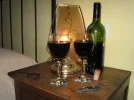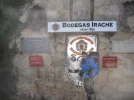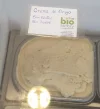- Time of past OR future Camino
- May 2023: Via Francigena, Lucca to Rome
I wanted to follow up on a post I saw a few months ago, but now I can't find it! I did my best to eat and drink like the locals, and so made a few discoveries (discoveries to me, at least) along the way. For those wanting to break free from the typical pilgrim *beer / rioja cycle, try these:
Coffee
Standard coffee terms are café con leche (we all know this one), cortado (espresso with a little bit of heated milk), café solo (a shot of espresso), solo doble (double shot of espresso). That last term is so simple, but it took awhile for me to figure out.
Coffee for pros
A carajillo is a shot of espresso mixed with brandy. I saw this mostly in the Basque areas, where they would heat up the brandy in the espresso machine before adding it to the coffee. The old men advised me to have one around 10 am, as it gives you "a little courage" for the day. This was less common as we moved west.
Afternoons
Patxaran (Spanish: pacharán) is a Basque liquor flavored with sloe berries, usually served over ice. Every bar had it in La Rioja and Navarre, though it also became less common as we moved west.
Anís is similar to other anise-flavored drinks in France and Spain. Was more common towards Galicia. At least, I first noticed it in that area.
Cerveza con limón. By the third hot day in Spain we had all discovered how good a cerveza con limón was after a long day's walk. Mahou Limón is the pre-made brand, though it's better freshly made.
.
Wine
As one French peregrino noted, the Spanish do horrible things to wine. Specifically, almost every bar serves their red wine chilled. We might have had some great reds along the way, but chilling it masks all the flavor. Ah well. Moving into Galicia, though, there are some interesting reds to try. Albariño is nice and crisp, and I think is more well known now. New to me was godello, which was a floral wine with just enough acidity to give it some depth. It pairs nicely with Gallego food!
In León I discovered Spanish vermut, which is served on the rocks or in a martini glass. It's not a mixer like in other countries! There are tapas bars dedicated to vermouth, and a lot have their own house brands. Apparently good vermouth is the new trendy drink in Madrid.
Chupitos
A chupito is an after-dinner shot. I didn't learn the word until my final week, though I had been hearing it and not quite catching what people were saying.
In Castilla y León & Galicia, at least, a chupito means a shot of arujo, which is like grappa. It's fire water! You can have some added to your coffee, or just have a shot after dinner. It's really, really strong, so drink carefully.
I had an interesting experience one night when I asked for a brandy after dinner. The bartender asked me what kind, and I didn't know. He pulled out three bottles. The first had a picture of a bull. "This is what pilgrims drink," he told me, "because it's the cheapest." The third was a top-shelf brand. That one was for the tourists. The middle bottle, he said, is what we (locals) drink. I took the middle bottle. I wish I remembered the name.
Finally, there was a yellow herbal liqueur that I cannot remember the name of & that other peregrinos told me was good. I forgot about it and never tried it.
*not that there's anything wrong with beer and rioja.
** I'm not fluent at all in Spanish, so feel free to add any nuances or corrections!
Coffee
Standard coffee terms are café con leche (we all know this one), cortado (espresso with a little bit of heated milk), café solo (a shot of espresso), solo doble (double shot of espresso). That last term is so simple, but it took awhile for me to figure out.
Coffee for pros
A carajillo is a shot of espresso mixed with brandy. I saw this mostly in the Basque areas, where they would heat up the brandy in the espresso machine before adding it to the coffee. The old men advised me to have one around 10 am, as it gives you "a little courage" for the day. This was less common as we moved west.
Afternoons
Patxaran (Spanish: pacharán) is a Basque liquor flavored with sloe berries, usually served over ice. Every bar had it in La Rioja and Navarre, though it also became less common as we moved west.
Anís is similar to other anise-flavored drinks in France and Spain. Was more common towards Galicia. At least, I first noticed it in that area.
Cerveza con limón. By the third hot day in Spain we had all discovered how good a cerveza con limón was after a long day's walk. Mahou Limón is the pre-made brand, though it's better freshly made.
.
Wine
As one French peregrino noted, the Spanish do horrible things to wine. Specifically, almost every bar serves their red wine chilled. We might have had some great reds along the way, but chilling it masks all the flavor. Ah well. Moving into Galicia, though, there are some interesting reds to try. Albariño is nice and crisp, and I think is more well known now. New to me was godello, which was a floral wine with just enough acidity to give it some depth. It pairs nicely with Gallego food!
In León I discovered Spanish vermut, which is served on the rocks or in a martini glass. It's not a mixer like in other countries! There are tapas bars dedicated to vermouth, and a lot have their own house brands. Apparently good vermouth is the new trendy drink in Madrid.
Chupitos
A chupito is an after-dinner shot. I didn't learn the word until my final week, though I had been hearing it and not quite catching what people were saying.
In Castilla y León & Galicia, at least, a chupito means a shot of arujo, which is like grappa. It's fire water! You can have some added to your coffee, or just have a shot after dinner. It's really, really strong, so drink carefully.
I had an interesting experience one night when I asked for a brandy after dinner. The bartender asked me what kind, and I didn't know. He pulled out three bottles. The first had a picture of a bull. "This is what pilgrims drink," he told me, "because it's the cheapest." The third was a top-shelf brand. That one was for the tourists. The middle bottle, he said, is what we (locals) drink. I took the middle bottle. I wish I remembered the name.
Finally, there was a yellow herbal liqueur that I cannot remember the name of & that other peregrinos told me was good. I forgot about it and never tried it.
*not that there's anything wrong with beer and rioja.
** I'm not fluent at all in Spanish, so feel free to add any nuances or corrections!






























